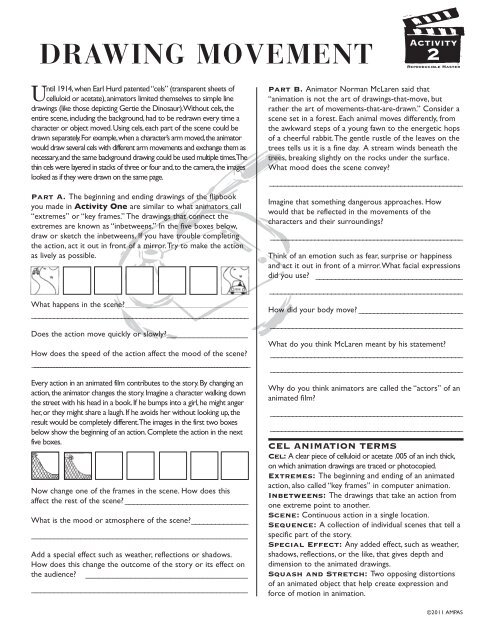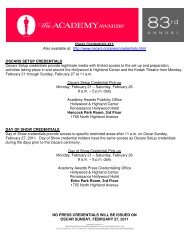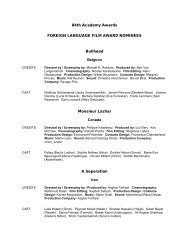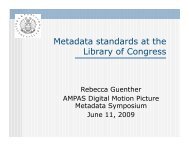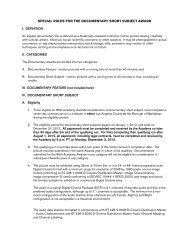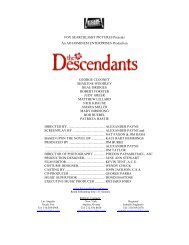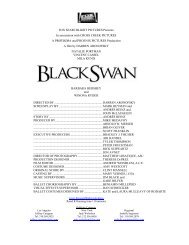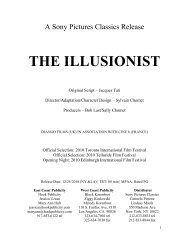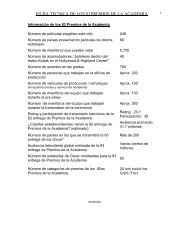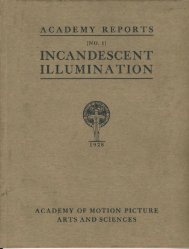CREATING MOVEMENT FRAME by FRAME - Academy of Motion ...
CREATING MOVEMENT FRAME by FRAME - Academy of Motion ...
CREATING MOVEMENT FRAME by FRAME - Academy of Motion ...
Create successful ePaper yourself
Turn your PDF publications into a flip-book with our unique Google optimized e-Paper software.
DRAWING <strong>MOVEMENT</strong> Activity<br />
2<br />
Reproducible Master<br />
Until 1914,when Earl Hurd patented“cels” (transparent sheets <strong>of</strong><br />
celluloid or acetate),animators limited themselves to simple line<br />
drawings (like those depicting Gertie the Dinosaur).Without cels,the<br />
entire scene,including the background,had to be redrawn every time a<br />
character or object moved.Using cels,each part <strong>of</strong> the scene could be<br />
drawn separately.For example,when a character’s arm moved,the animator<br />
would draw several cels with different arm movements and exchange them as<br />
necessary,and the same background drawing could be used multiple times.The<br />
thin cels were layered in stacks <strong>of</strong> three or four and,to the camera,the images<br />
looked as if they were drawn on the same page.<br />
Part A. The beginning and ending drawings <strong>of</strong> the flipbook<br />
you made in Activity One are similar to what animators call<br />
“extremes” or “key frames.” The drawings that connect the<br />
extremes are known as “inbetweens.” In the five boxes below,<br />
draw or sketch the inbetweens. If you have trouble completing<br />
the action, act it out in front <strong>of</strong> a mirror.Try to make the action<br />
as lively as possible.<br />
What happens in the scene? ____________________________________________________________________<br />
__________________________________________________________<br />
Does the action move quickly or slowly?__________________<br />
How does the speed <strong>of</strong> the action affect the mood <strong>of</strong> the scene?<br />
________________________________________________________________________________<br />
Every action in an animated film contributes to the story.By changing an<br />
action,the animator changes the story.Imagine a character walking down<br />
the street with his head in a book.If he bumps into a girl,he might anger<br />
her,or they might share a laugh.If he avoids her without looking up,the<br />
result would be completely different.The images in the first two boxes<br />
below show the beginning <strong>of</strong> an action.Complete the action in the next<br />
five boxes.<br />
Now change one <strong>of</strong> the frames in the scene. How does this<br />
affect the rest <strong>of</strong> the scene? ______________________________<br />
What is the mood or atmosphere <strong>of</strong> the scene?______________<br />
________________________________________________<br />
Add a special effect such as weather, reflections or shadows.<br />
How does this change the outcome <strong>of</strong> the story or its effect on<br />
the audience? ____________________________________<br />
________________________________________________<br />
Part B. Animator Norman McLaren said that<br />
“animation is not the art <strong>of</strong> drawings-that-move, but<br />
rather the art <strong>of</strong> movements-that-are-drawn.” Consider a<br />
scene set in a forest. Each animal moves differently, from<br />
the awkward steps <strong>of</strong> a young fawn to the energetic hops<br />
<strong>of</strong> a cheerful rabbit.The gentle rustle <strong>of</strong> the leaves on the<br />
trees tells us it is a fine day. A stream winds beneath the<br />
trees, breaking slightly on the rocks under the surface.<br />
What mood does the scene convey?<br />
__________________________________________________<br />
Imagine that something dangerous approaches. How<br />
would that be reflected in the movements <strong>of</strong> the<br />
characters and their surroundings?<br />
____________________________________________________<br />
Think <strong>of</strong> an emotion such as fear, surprise or happiness<br />
and act it out in front <strong>of</strong> a mirror.What facial expressions<br />
did you use? ______________________________________<br />
__________________________________________________<br />
How did your body move? ____________________________<br />
____________________________________________________<br />
What do you think McLaren meant <strong>by</strong> his statement?<br />
____________________________________________________<br />
____________________________________________________<br />
Why do you think animators are called the “actors” <strong>of</strong> an<br />
animated film?<br />
____________________________________________________<br />
____________________________________________________<br />
CEL ANIMATION TERMS<br />
Cel: A clear piece <strong>of</strong> celluloid or acetate .005 <strong>of</strong> an inch thick,<br />
on which animation drawings are traced or photocopied.<br />
Extremes: The beginning and ending <strong>of</strong> an animated<br />
action, also called “key frames” in computer animation.<br />
Inbetweens: The drawings that take an action from<br />
one extreme point to another.<br />
Scene: Continuous action in a single location.<br />
Sequence: A collection <strong>of</strong> individual scenes that tell a<br />
specific part <strong>of</strong> the story.<br />
Special Effect: Any added effect, such as weather,<br />
shadows, reflections, or the like, that gives depth and<br />
dimension to the animated drawings.<br />
Squash and Stretch: Two opposing distortions<br />
<strong>of</strong> an animated object that help create expression and<br />
force <strong>of</strong> motion in animation.<br />
©2011 AMPAS


